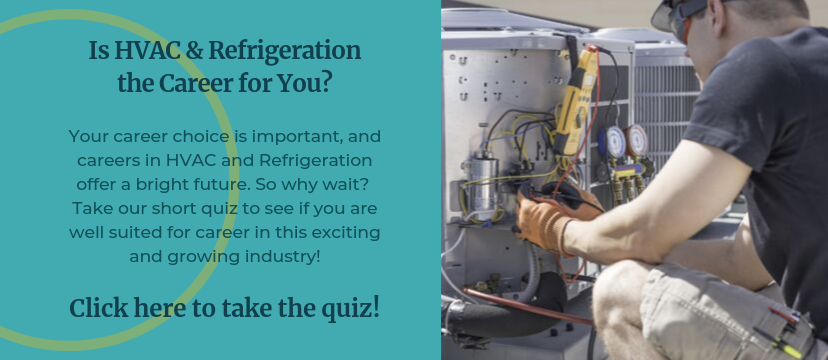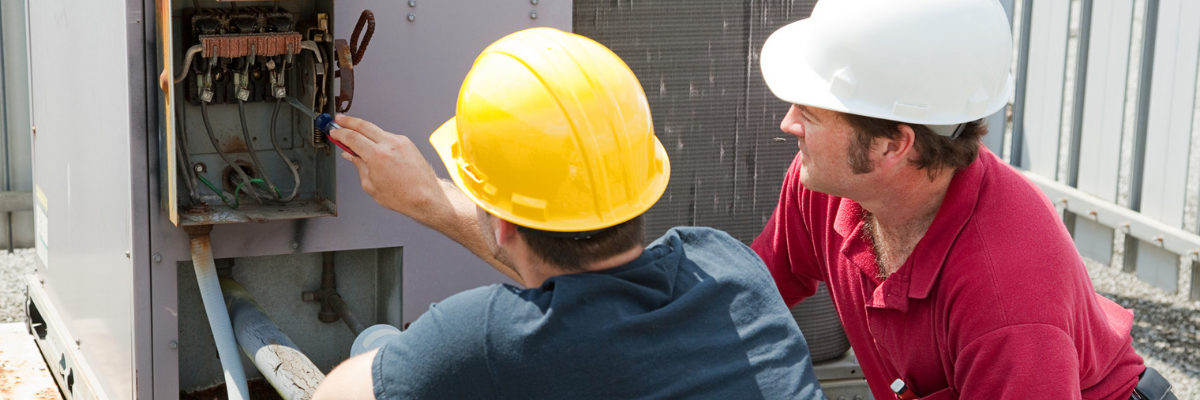HVAC apprentice jobs offer attractive benefits, such as:
- six-figure earnings potential within 5 years (without college or student loan debt)
- excellent union benefits
- job security
- interesting and varied work
For most new recruits to the industry, the path begins with an HVAC technician apprenticeship. An apprenticeship is a period of time when you’re learning through on-the-job training plus more formal classroom training. It can take 4 years or longer to complete before you become a fully qualified journeyman.
It’s an investment of time, but the upside is that you get to earn good money while you work as a helper learning the skills of the trade. That’s a big difference from many careers where you have to pay for college or other types of training before you can start earning money.
Here’s what you can expect as you begin an HVAC technician apprenticeship.
Getting hands-on with a variety of tasks
Many men and women get started in HVAC service by getting hired as a “helper” or “junior” technician. This is the first step in an HVAC technician apprenticeship, and you don’t need any experience or training to get hired. (That said, there are skills and qualities that employers look for. Take our quiz to find out if you’re a good fit.)

What does an HVAC apprentice or helper do?
As a helper, apprentice, or junior tech, you spend your time working alongside a more experienced HVAC or Refrigeration technician, typically someone who has been in the field for at least 3 years.
“Your first year is primarily spent as a second man,” explained Tiziano Sartori of Donnelly Mechanical in New York City. “You are a set of hands and you’re assisting technicians out in the field to perform various tasks. You may be teamed up with one person, or bouncing around to help members of a team.”
As you progress in your skills, you may be assigned specific tasks related to a larger repair or maintenance job, such as replacing a part or changing a filter. Depending on the company you work for, you may get the chance to be involved in different aspects of HVAC and Refrigeration work, including repair, installation, and preventative maintenance. Each of these areas require specific skill sets.
“We try to expose the junior guys to as many different things as possible and see what really works for them,” said Sartori.
As a new technician gets more qualified, on-the-job training will often progress to a more consistent mentorship experience. If you prove to be well suited to maintenance work, for example, you may be assigned to work exclusively with a field supervisor on maintenance calls for several months or longer. At that point, you learn about every aspect of the work, including completing paperwork, following company reporting procedures, and customer service skills.
Pay and benefits
When an employer hires you as a new service technician, there will be a trial period of 30 to 45 days before the company enrolls you in the union.
Once you get enrolled, you start earning paid vacation, holidays, and sick time. After you work as a union member for 160 hours (about a month), you start receiving medical benefits.
Your employer also makes contributions to the union on your behalf, for things like your pension fund (did we mention that you’ll be earning a pension?) and education. You also pay a small fee for union dues.
Here’s the part you’ve been waiting for: here’s how much can you earn as a union HVAC technician in the NYC area.
You’ll make about $15 per hour when you start your HVAC technician apprenticeship and join the union. After only 6 months, you’ll make $20.51 per hour. After one year, your pay rate jumps to $24.74. The rate goes up every year until you become a journeyman making $42.35 per hour. When you factor in overtime (and sometimes double time pay), you can be earning over $100,000 within five years.
For details, see the UA Local 638 published wage rates.
Formal training during your HVAC technician apprenticeship
Employers will take one or more of these approaches to training new recruits to an HVAC technician apprenticeship:
- Training new technicians themselves with an in-house training program
- Sending technicians to training classes given by equipment manufacturers
- Enrolling technicians in the local union’s training program
Company training
In addition to having new techs learn by following senior technicians on the job, many HVAC employers provide classroom-style training to teach the basic principles behind the work. That includes understanding the basics of electricity, the refrigerant cycles, and troubleshooting practices. Classes are often hands-on, allowing new techs to try out different tasks in a controlled setting.
Some of those classes may take place on weekends and on your own time.
Manufacturer training
HVAC equipment manufacturers are continuously improving their technology and coming out with new equipment lines, models, and features. When something new is available, manufacturers will frequently offer training to bring technicians up to speed on what’s new and provide instructions for installing, troubleshooting, repairing and maintaining the new equipment.
Sartori explains why this training is so important. “You can no longer just go to a machine and, through using a set of refrigerant gauges and an amp probe, tell what’s going on with the machine. You need to connect with a laptop and an interface tool, and be trained on how to do that and get diagnostic reports.”
Technicians will typically go to a manufacturer facility for training. For larger HVAC companies, manufacturers may send a rep to train a large group of technicians at once.
Union training
Here in the NYC metro area, UA Local 638 provides a contractor-sponsored 3 year HVAC technician training program, plus a new New York State approved 4 year HVAC technician apprenticeship training program.
What does contractor-sponsored mean? It means your employer enrolls you in the training program and pays for it. However, not every employer chooses to send their technicians to the union program. And, there is sometimes more demand than available seats in the training class. In that case, applicants complete a short exam covering basic math and reading skills to select the participants for that year.
The training program has two terms per year, each term running for 13 weeks. For the first two years of training, participants attend classes one day per week, while also working for their employer as a helper or junior technician for the remainder of the week. At the end of the term, participants complete final exams, and their grades and attendance records are reported to the employer. After 2 years, participants work full time for their employer, and attend classes in the evening on their own time.
HVACR Career Connect NY was created to promote the exceptional quality-of-life benefits of a career in HVAC and Refrigeration service, and also to provide a clear path for getting started in the profession. In doing so, we serve as a resource for employers in the New York City metro area to find and hire smart and capable new technicians. We also serve as an educational resource to support business growth and to help service technicians succeed in their chosen profession.
